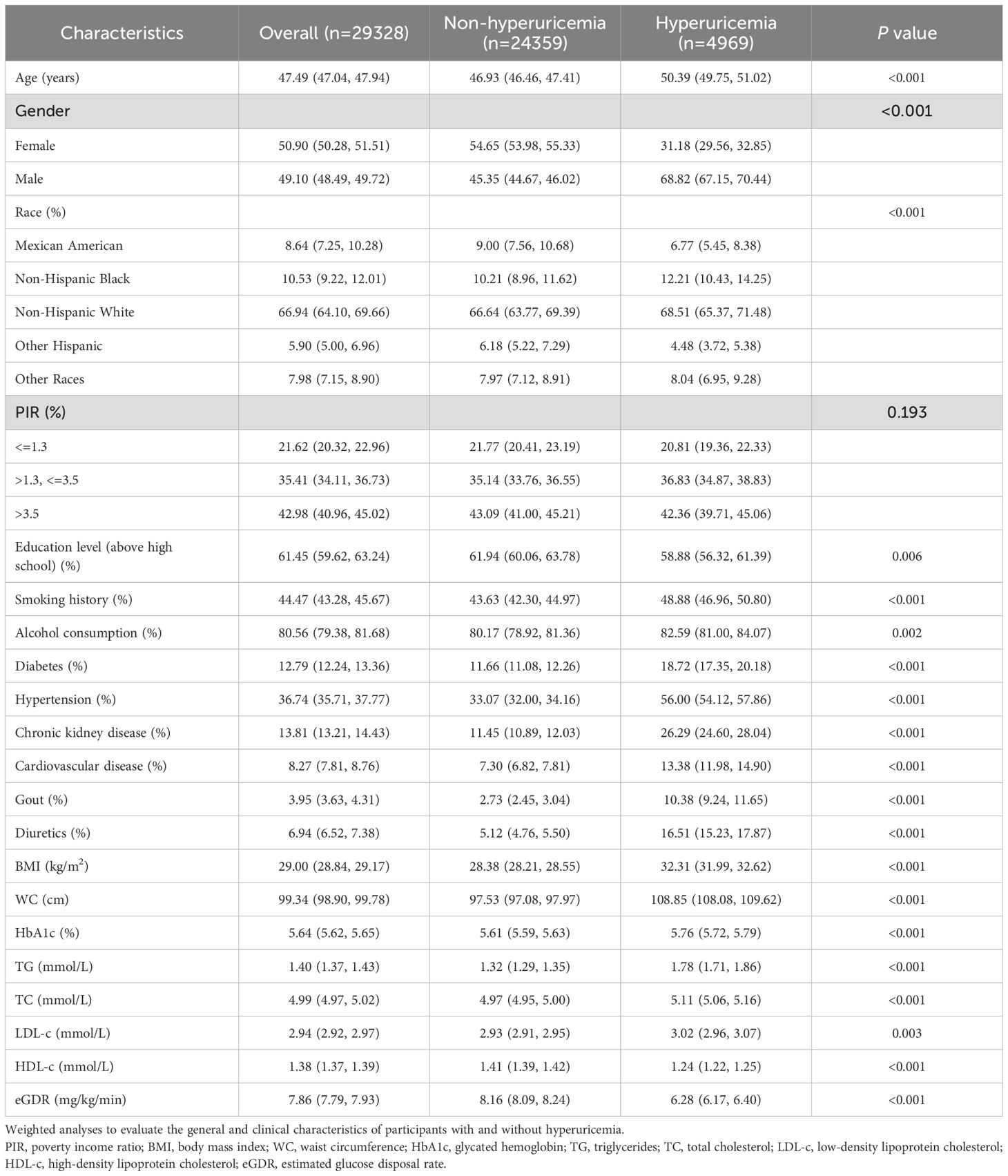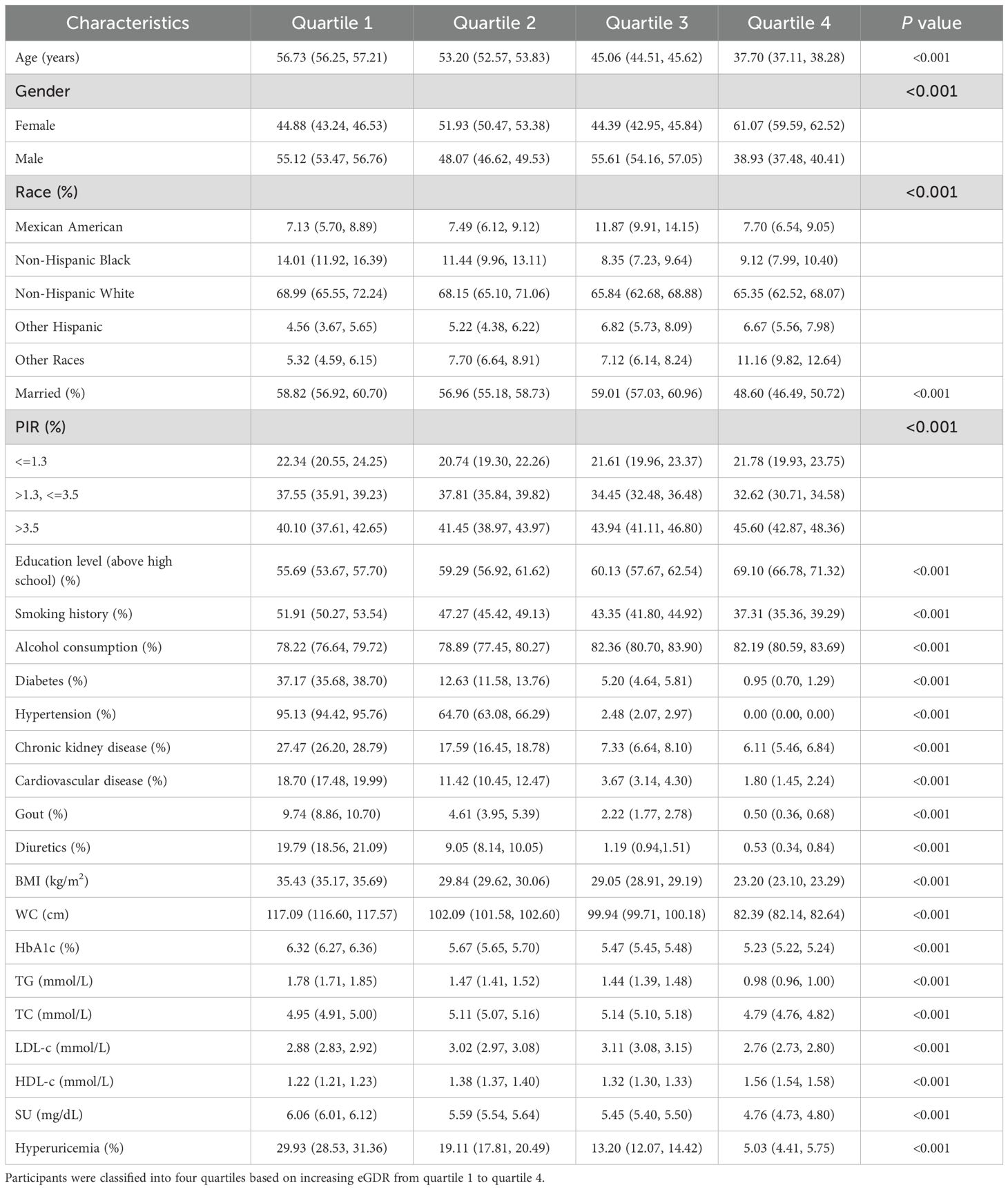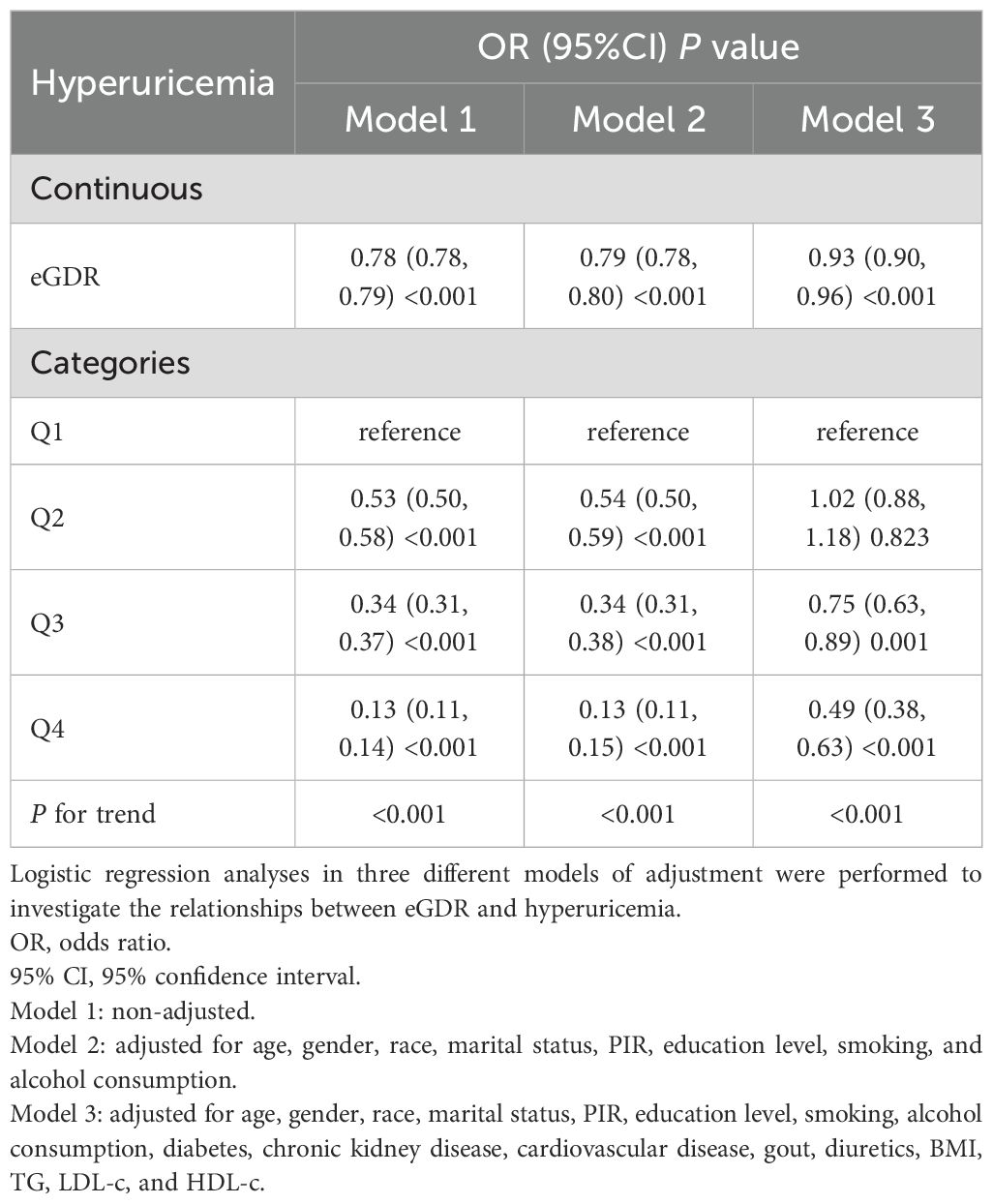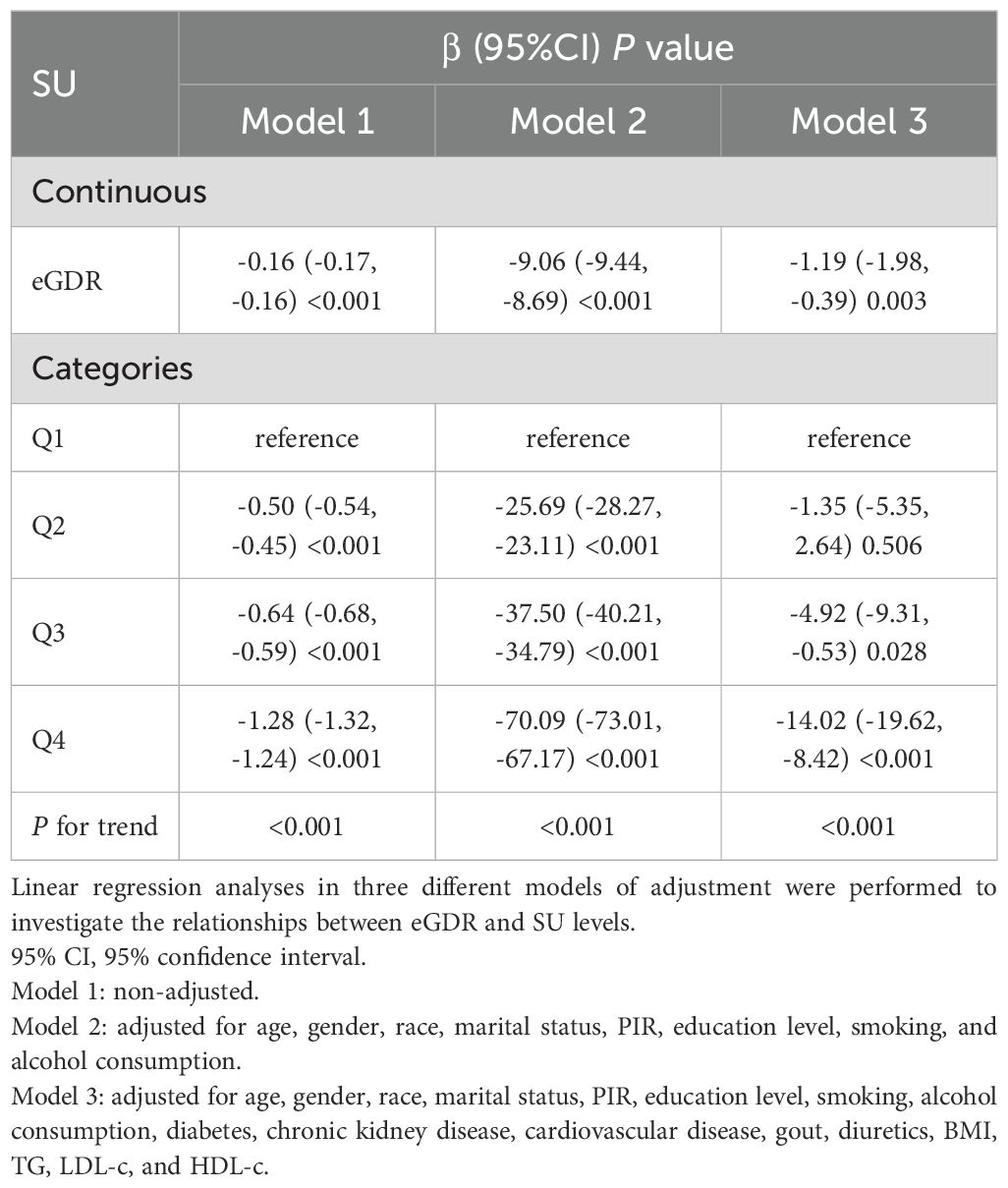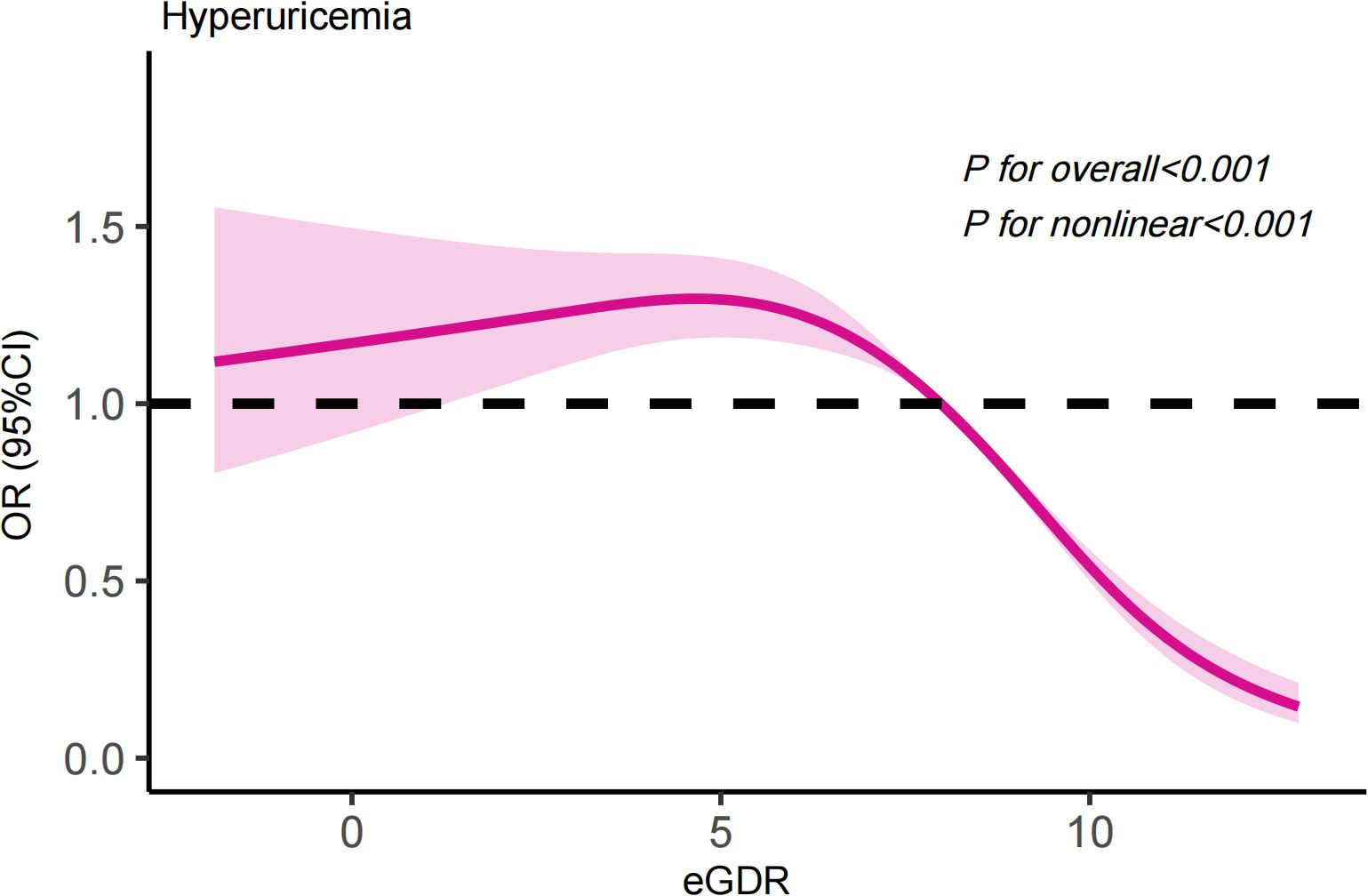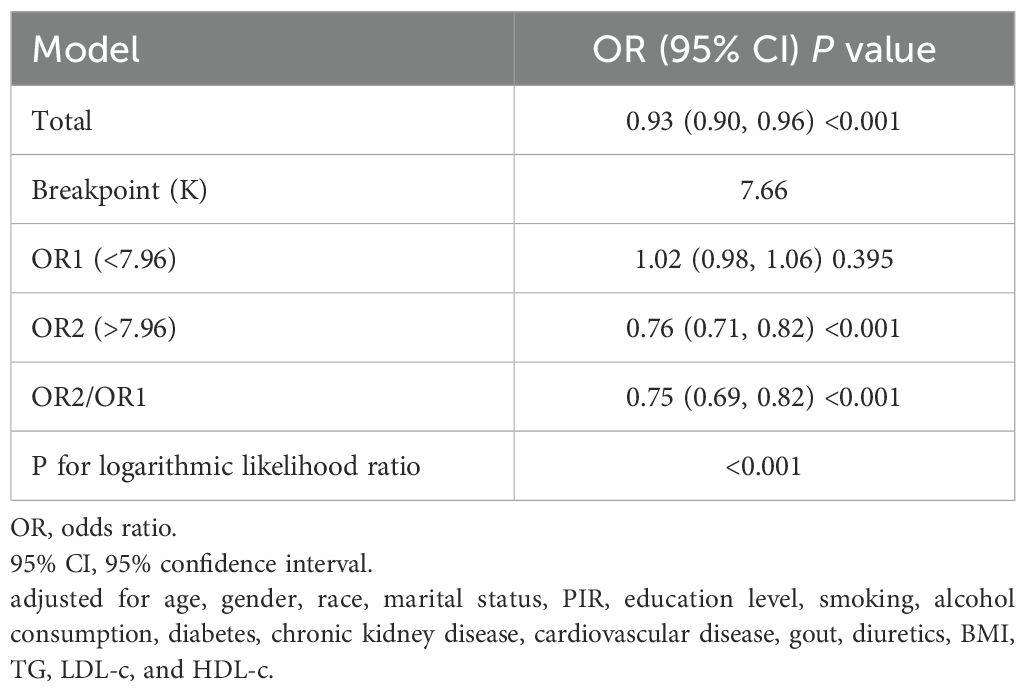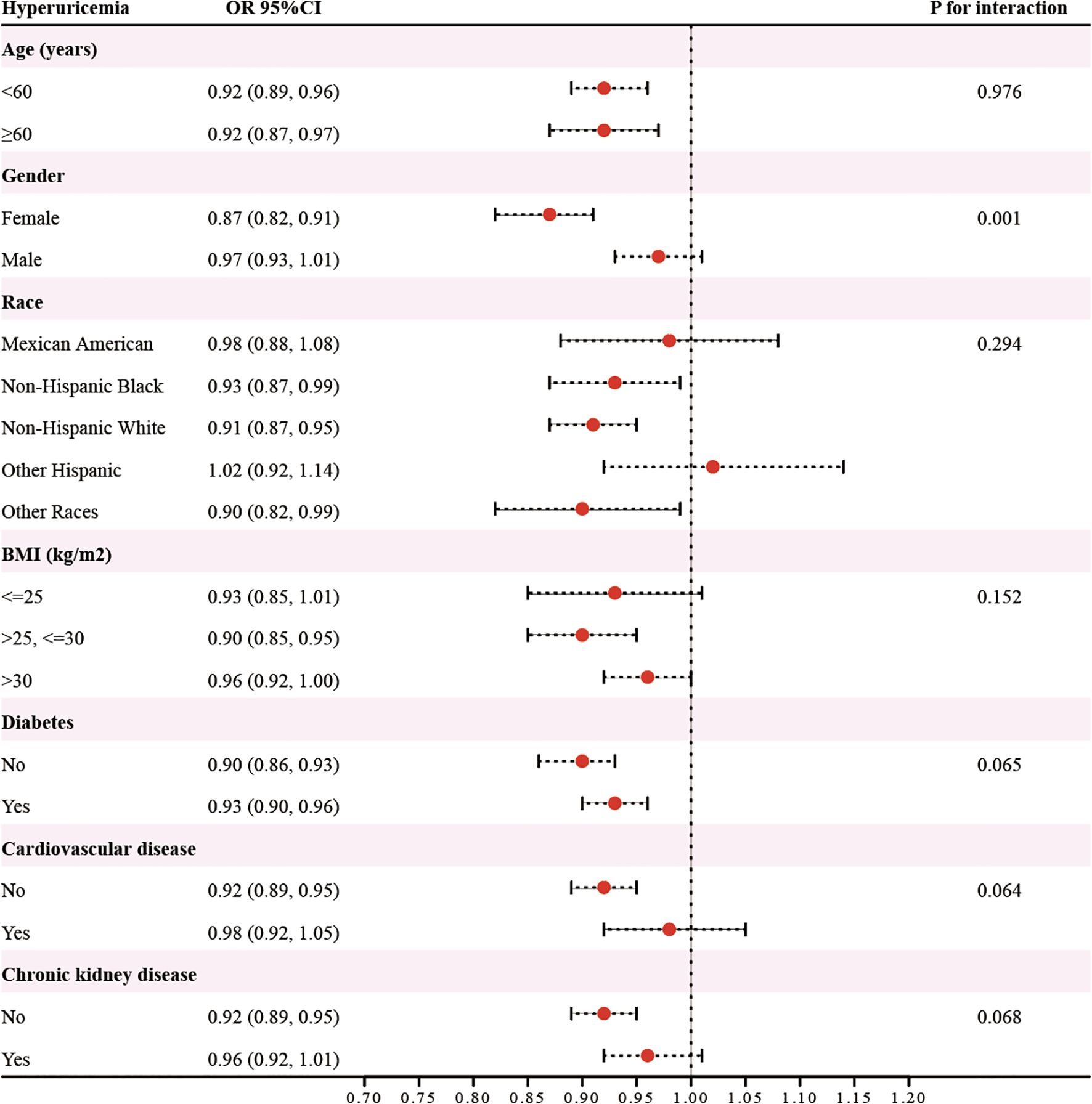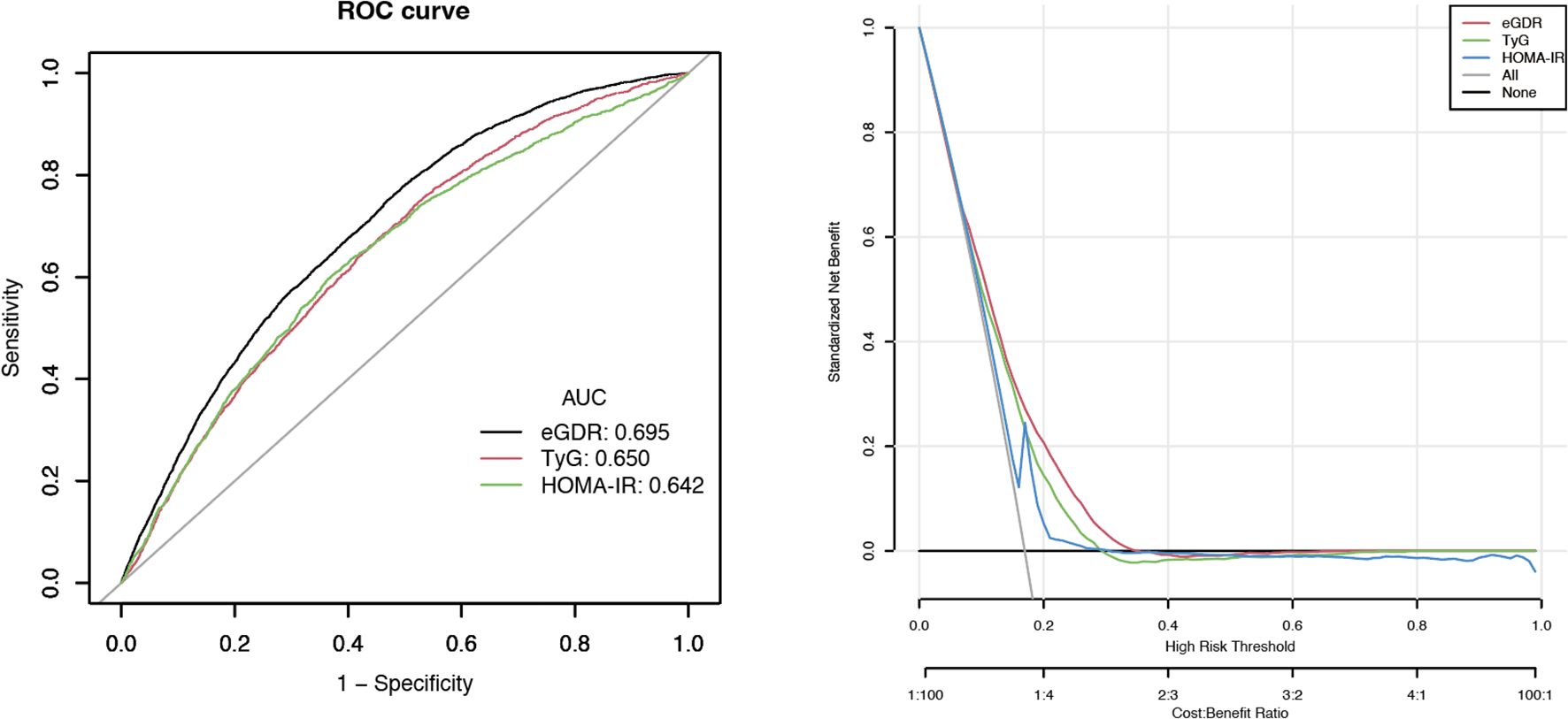- 1Department of Endocrinology, Affiliated Kunshan Hospital of Jiangsu University, Kunshan, Jiangsu, China
- 2Department of Endocrinology, The First Affiliated Hospital of Nanjing Medical University, Nanjing, Jiangsu, China
- 3Department of Clinical Nutrition, Hangzhou Hospital of Traditional Chinese Medicine, Hangzhou, Zhejiang, China
Purpose: The estimated glucose disposal rate (eGDR) is a simple and noninvasive clinical measure used to assess insulin resistance (IR), yet its potential utility as a marker for hyperuricemia risk had not been systematically evaluated. This study aimed to investigate the relationship between eGDR and hyperuricemia risk among American adults.
Methods: Data for this cross-sectional study were obtained from the 2007–2018 National Health and Nutrition Examination Survey (NHANES). Hyperuricemia was identified as a serum urate (SU) concentration of ≥7 mg/dL in males and ≥6 mg/dL in females. The relationship between eGDR and hyperuricemia risk was assessed using multivariate logistic regression and restricted cubic spline (RCS) methods, with additional subgroup and interaction analyses performed.
Results: With increasing eGDR values, the prevalence of hyperuricemia decreased significantly (29.93% vs. 19.11% vs. 13.20% vs. 5.03%, P<0.001). Multivariate logistic regression indicated that eGDR was independently associated with the risk of hyperuricemia after controlling for covariates including demographic, lifestyle, and clinical factors (OR=0.93, 95%CI: 0.90-0.96, P<0.001). RCS analysis further revealed a nonlinear relationship, with a turning point at eGDR 7.96 mg/kg/min. Subgroup analysis revealed a stronger inverse association between eGDR and hyperuricemia risk in females.
Conclusions: The eGDR is inversely associated with hyperuricemia and appears to be a promising epidemiological tool for evaluating the impact of IR on the risk of hyperuricemia.
1 Introduction
Hyperuricemia, characterized by abnormally high uric acid levels in the blood, is a common chronic metabolic condition (1). It serves as a key factor in the development of gout (a very painful long-term systemic inflammatory arthritis caused by the deposition of monosodium urate crystal) (2, 3) and has been increasingly associated with conditions such as diabetes, metabolic syndrome, cardiovascular diseases, and higher mortality rates (4–6). In recent years, the global rise in hyperuricemia cases has placed a considerable burden on healthcare systems and economies (7).
Insulin resistance (IR) is an important pathophysiological risk factor for hyperuricemia (8). IR, with consequent compensatory hyperinsulinemia, can disrupt uric acid homeostasis by altering renal urate excretion and potentially increasing de novo uric acid production (8, 9). The hyperinsulinemic-euglycemic clamp remains the most reliable method for measuring insulin resistance; however, its use in large-scale epidemiological studies is constrained by the complexity and time requirements of the procedure (10). The estimated glucose disposal rate (eGDR) is a clinical parameter-based index for evaluating insulin sensitivity (11). Initially developed for type 1 diabetes (T1DM) patients, it incorporates variables such as waist circumference (WC), glycated hemoglobin (HbA1c), and hypertension status (12, 13). Moreover, the recognition exists that these individual risk factors (including central obesity, hypertension, and inflammatory states), integral to the eGDR and often co-manifesting, are capable of mechanistically altering the intricate dynamics between glucose regulation and uric acid levels by exacerbating overall metabolic dysregulation. Lower eGDR values indicate poorer insulin sensitivity and greater IR. Compared with traditional methods such as the homeostasis model assessment of insulin resistance (HOMA-IR) and the triglyceride-glucose (TyG) index, eGDR demonstrates superior performance, is simpler to use, does not require fasting blood samples, and is particularly well-suited for large-scale studies (14, 15). Recently, research has shown that eGDR effectively reflects IR and is strongly linked to metabolic syndrome, cardiovascular diseases, and diabetes complications (11, 16–19).
Although IR is a well-established correlate of hyperuricemia with multiple established measurement indices, a notable research gap persists regarding the eGDR. The potential value of eGDR as a simple, non-fasting metric requiring only basic clinical parameters-which could serve as a robust insulin sensitivity marker particularly advantageous for large-scale epidemiological studies and hyperuricemia risk stratification in diverse populations-remains insufficiently investigated. Given the absence of studies on eGDR and hyperuricemia risk, our research, utilizing the National Health and Nutrition Examination Survey (NHANES) data, examine this relationship in the U.S. population. We predict that increased eGDR values are associated with a reduced risk of hyperuricemia.
2 Materials and methods
2.1 Study population
Data for this study were drawn from NHANES, a survey conducted by the National Center for Health Statistics at the Centers for Disease Control and Prevention (CDC). The survey used a stratified, randomized, multi-stage sampling approach to ensure a nationally representative sample. Participants underwent physical examinations, completed health and nutrition surveys, and participated in laboratory tests. The NHANES protocol was reviewed and approved by the Ethics Review Board of the National Center for Health Statistics (NCHS), and written informed consent was collected from all participants. Detailed methodologies and datasets are available at https://wwwn.cdc.gov/nchs/nhanes/. The NHANES cycles from 2007 to 2018, comprising 59842 participants, were utilized in this study, with exclusions applied to individuals under 20, pregnant women, and those lacking complete eGDR and uric acid data, resulting in 29328 participants.
2.2 Definition of eGDR and hyperuricemia
The eGDR (mg/kg/min) is estimated using the formula: eGDR = 21.158 − (0.09 × WC) − (3.407 × HTN) − (0.551 × HbA1c) (13, 20). In this equation, WC represents waist circumference in centimeters, HTN indicates hypertension status (1 = yes, 0 = no), and HbA1c refers to glycated hemoglobin (%). Hyperuricemia is determined by serum urate (SU) levels of 7 mg/dL or more in men and 6 mg/dL or more in women (21).
2.3 Assessment of covariates
In this study, covariates included demographic characteristics (age, gender, and race), socio-economic factors (marital status, income, and education), smoking history, alcohol consumption, diuretics use, health conditions (hypertension, diabetes, cardiovascular disease, chronic kidney disease, and gout), and other indicators such as body mass index (BMI), WC, HbA1c, triglycerides (TG), total cholesterol (TC), high-density lipoprotein cholesterol (HDL-c), and low-density lipoprotein cholesterol (LDL-c). Smoking history encompasses both current and former smoking. Alcohol consumption was determined having consumed at least 12 alcoholic drinks in the past year. Use of diuretics was determined based on responses to the question: “During the past 30 days, have you used or taken any prescription medications?”. Diagnosis of chronic kidney disease was determined by an estimated glomerular filtration rate (eGFR) below 60 mL/min/1.73 m² and/or a urine albumin-to-creatinine ratio (UACR) of 30 mg/g or more. The eGFR was calculated using the Chronic Kidney Disease Epidemiology Collaboration (CKD-EPI) equation, which incorporates age, gender, race, and serum creatinine (Scr) levels (22). Diabetes was diagnosed based on a self-reported history, fasting plasma glucose (FPG) levels of ≥7.0 mmol/L, HbA1c levels of ≥6.5%, or the use of antidiabetic drugs. Hypertension was defined as a self-reported history, systolic blood pressure (SBP) ≥140 mmHg, diastolic blood pressure (DBP) ≥90 mmHg, or the use of antihypertensive medications. Cardiovascular diseases were identified through participants’ self-reported histories of heart attacks, strokes, heart failure, coronary artery disease, or angina. The presence of gout was established through the question: “Has a doctor or other health professional ever told you that you have gout?”. Full methodological details for each variable analyzed in this research are publicly accessible via the NHANES database (https://wwwn.cdc.gov/nchs/nhanes/).
2.4 Statistical analysis
In accordance with CDC guidelines, statistical analyses utilized a complex multistage cluster survey design and incorporated sampling weights. Continuous variables were presented as means with 95% confidence intervals (CIs), while categorical variables were summarized as percentages with 95% CIs. Weighted Student’s t-tests and chi-squared tests were used to evaluate group differences in continuous and categorical variables, respectively. Logistic and linear regression models were applied to investigate the relationships between eGDR and hyperuricemia or SU levels. To assess potential nonlinear associations between eGDR and hyperuricemia risk, restricted cubic spline (RCS) regression with four knots was performed, with the median value as the reference point. A two-piecewise regression model was employed to identify intervals, and the Log-likelihood ratio test was used to evaluate the presence of a threshold effect. Subgroup analyses were carried out based on covariate stratification, with the other covariates being adjusted for. Receiver operating characteristic (ROC) curve analysis and decision curve analysis (DCA) were employed to compare the classification accuracy and clinical utility of eGDR with those of other alternative indicators. Statistical analyses in this research were performed using Empower software (http://www.empowerstats.com) and R software (http://www.R-project.org), with a two-sided P value < 0.05 considered statistically significant.
3 Results
3.1 Baseline characteristics of study population.
The study population consisted of 29328 participants with a mean age of 47.49 years. The racial composition included 8.64% Mexican Americans, 10.53% Non-Hispanic Blacks, 66.94% Non-Hispanic Whites, 5.90% Other Hispanics, and 7.98% from other racial groups. A weighted analysis was performed to evaluate the general and clinical characteristics of participants with and without hyperuricemia (Table 1). The results showed that individuals with hyperuricemia were generally older, predominantly male, more likely to smoke and consume alcohol, and more frequently used diuretics (P<0.01). They also had higher prevalence rates of diabetes, hypertension, chronic kidney disease, cardiovascular disease, gout, as well as elevated BMI, WC, HbA1c, TG, TC, and LDL-c levels (P<0.001). Additionally, they were found to have lower educational attainment and reduced HDL-c levels (P<0.01). Furthermore, eGDR levels were significantly reduced in the hyperuricemia group compared to the non-hyperuricemia group (P<0.001).
3.2 Baseline characteristics of four different quartiles (1-4) based on increasing eGDR values.
Participants were classified into four groups based on eGDR quartiles (Table 2). Compared to those in the lowest quartile, individuals in the higher quartiles were younger, more likely to be female and drinkers, and had lower rates of smoking, diuretic use, diabetes, hypertension, chronic kidney disease, cardiovascular disease, and gout (P<0.001). They also tended to have higher levels of education and a greater PIR (poverty income ratio) (P<0.001). Significant reductions were noted in BMI, WC, HbA1c, TG, TC, and LDL-c levels, while HDL-c levels were significantly higher (P<0.001). Race distribution also differed significantly (P<0.001). SU levels and hyperuricemia prevalence decreased with rising eGDR levels which is in agreement with the previous report (23) (P<0.001).
3.3 Analyzing the relationship between eGDR and hyperuricemia or SU levels using Logistic and Linear regression analysis.
Our findings demonstrate a significant negative association between elevated eGDR levels and hyperuricemia, which persists across models 1 (OR=0.78, 95%CI: 0.78-0.79, P<0.001), 2 (OR=0.79, 95%CI: 0.78-0.80, P<0.001), and 3 (OR=0.93, 95%CI: 0.90-0.96, P<0.001) (Table 3). Further stratification by eGDR quartiles, using the lowest quartile as a reference, shows that individuals in the highest quartile also have a lower risk of hyperuricemia in the fully adjusted model (OR=0.49, 95%CI: 0.38-0.63, P<0.001). The analysis of SU levels as the dependent variable and eGDR levels as the independent variable through linear regression also demonstrates a negative relationship between them (β=-1.19, 95%CI: -1.98–0.39, P=0.003) (Table 4).
3.3 RCS analysis
RCS analysis to assess non-linearity in the relationship between eGDR and hyperuricemia (Figure 1). The threshold effect analysis shows that the inflection point for eGDR levels is 7.66 mg/kg/min, with a more pronounced relationship on the right side (OR=0.76, 95%CI: 0.71-0.82, P<0.001) compared to the left side (OR=1.02, 95%CI: 0.98-1.06, P=0.395) (Table 5).
3.4 Subgroup analyses
In analyses stratified by variables such as age (<60/≥60 years), gender (female/male), race (Mexican American/Non-Hispanic Black/Non-Hispanic White/Other Hispanic/Other Races), BMI (≤25/25-30/>30 kg/m2), diabetes (yes/no), cardiovascular disease (yes/no), and chronic kidney disease (yes/no), the association between eGDR and hyperuricemia risk was significantly stronger in females (OR=0.87, 95%CI: 0.82-0.91) than in males (OR=0.97, 95%CI: 0.93-1.01) (P for interaction=0.001)(Figure 2). Across other subgroups, the relationship showed no significant variation (P for interaction > 0.05).
3.5 ROC and DCA analyses
We evaluated eGDR in comparison with other IR surrogates, such as the Triglyceride-Glucose index (TyG) and Homeostasis Model Assessment of Insulin Resistance (HOMA-IR). As illustrated in Figure 3, both ROC and DCA analyses were performed. The area under the curves (AUCs) for eGDR, TyG, and HOMA-IR were 69.5%, 65.0%, and 64.2%, respectively, highlighting eGDR as the most effective discriminator for hyperuricemia risk. Moreover, DCA indicated that the eGDR model offered increased net benefit across a broader range of threshold probabilities, reflecting its superior clinical usefulness.
4 Discussion
This study reports the results of our investigation about whether the eGDR, used to assess IR, can serve as a straightforward and noninvasive indicator of hyperuricemia. A cross-sectional analysis of 29328 participants revealed a negative and nonlinear correlation between the eGDR and the risk of hyperuricemia.
IR and SU levels were described bidirectionally interconnected because higher SU levels are known to adversely affect the insulin signaling pathway causing IR while IR is a known predictor for the development of hyperuricemia (8, 24). Renal anti-uricosuric effect of insulin was also described preserved in states of IR in human. In compensatory hyperinsulinemia in the state of IR a chronic anti-uricosuric pressure on the kidney cause in hyperuricemia (25). In an in vitro experiment, insulin was shown to stimulate urate uptake in human proximal tubular cells (PTC-05) and HEK293T cells and in Xenopus oocyte expression system, where insulin was shown to stimulate urate uptake activity of urate reabsorption transporter, glucose transporter 9 (GLUT9) (26). The eGDR, which is based on clinical parameters, provides a practical and accurate assessment of insulin sensitivity and resistance (27). Specifically, the three components of eGDR reflect IR from different perspectives: Increased WC indicates visceral fat accumulation, which can promote the release of inflammatory factors, exacerbate IR, and reduce renal uric acid excretion, thereby leading to elevated SU levels (28). Hypertension is often associated with IR and may reduce uric acid clearance through renal hemodynamic alterations (29). Elevated HbA1c reflects chronic hyperglycemia and IR, both of which can also influence the renal tubular handling of uric acid (30). Our study found a nonlinear association between eGDR and the risk of hyperuricemia. When eGDR is below the threshold of 7.66, increases in eGDR have limited impact on hyperuricemia risk. However, once eGDR exceeds 7.66, further increases are significantly associated with a reduced risk of hyperuricemia. Therefore, eGDR may serve as a simple and practical screening tool for assessing hyperuricemia risk, especially in primary care settings where more complex measures of IR are unavailable. We propose 7.66 as a potential cutoff value for screening purposes. Our research also revealed that the relationship between eGDR and hyperuricemia risk was stronger in women, potentially reflecting their distinct physiological traits in metabolic regulation (31). Additionally, estrogen plays a role in reducing inflammation and enhancing insulin sensitivity, but its decline after menopause may worsen insulin resistance and disrupt uric acid metabolism (32–35). Estradiol reduces the expression of urate reabsorption transporters, including urate transporter 1 (URAT1) and GLUT9, as well as the efflux transporter ATP-binding cassette sub-family G member 2 (ABCG2), in ovariectomized mice, regardless of hormone replacement therapy (36). Additionally, 17-β-estradiol (E2) has been found to decrease GLUT9 protein levels in human renal tubular epithelial cells (HK2) through estrogen receptor β (ERβ) (37).
The interaction between IR and hyperuricemia is bidirectional, with both conditions sharing metabolic and pathological mechanisms that perpetuate a vicious cycle (4). Obesity, hyperglycemia, and lipid metabolism disorders are common factors linking IR and hyperuricemia, as they promote purine metabolism, oxidative stress, and inflammation, leading to increased uric acid production and decreased insulin sensitivity (38, 39). Clinical evidence showing that allopurinol combined with standard treatment in severe Covid-19 patients reduced oxidative and inflammatory disorders, suggesting that lowering serum urate levels can mitigate oxidative stress (40). In hyperuricemia, reactive oxygen species (ROS) are overproduced during uric acid formation by xanthine oxidases. Both ROS and intracellular uric acid can regulate multiple signaling pathways. For instance, studies demonstrate increased ROS production during 3T3-L1 cell differentiation into adipocytes, indicating that ROS generation correlates with fat accumulation. Interestingly, in fully differentiated 3T3-L1 adipocytes, ROS production was markedly inhibited by NADPH oxidase inhibitors, but not by oxypurinol, rotenone, or thenoyltrifluoroacetone (41).
Uric acid is recognized as an important antioxidant in vivo, capable of scavenging ROS such as hydroxyl radicals and peroxynitrite (42, 43). However, under severe oxidative stress, its antioxidant capacity may be overwhelmed, potentially disrupting metabolic homeostasis. Although xanthine oxidase is a key enzyme in uric acid production and a known source of ROS, the relationship between oxidative stress and xanthine oxidase activity remains complex. Some studies indicate that oxidative stress in hyperuricemia may occur independently of xanthine oxidase activity (44), and clinical trials with xanthine oxidase inhibitors (e.g., allopurinol, febuxostat) have yielded inconsistent effects on oxidative stress-related outcomes. Therefore, further research is needed to clarify whether oxidative stress directly disrupts uric acid metabolism or whether their interaction involves additional regulatory mechanisms.
However, this study has limitations. First, given the study’s cross-sectional design, the direction of causality cannot be ascertained, and the role of hyperuricemia in amplifying IR cannot be ruled out. Second, although adjustments were made for several covariates, the effects of unaccounted confounders such as treatment with allopurinol and differences in diuretic use cannot be entirely ruled out. Third, subgroup analyses for factors such as diabetes types, nonalcoholic fatty liver disease (NAFLD) and metabolic syndrome were not performed. Finally, our results, derived from a US population sample, require further verification to ensure their applicability to other demographic groups.
5 Conclusion
A nationally representative study among adults aged 20 years or older identified a negative association between the eGDR and the risk of hyperuricemia.
Data availability statement
Publicly available datasets were analyzed in this study. This data can be found here: https://wwwn.cdc.gov/nchs/nhanes.
Ethics statement
The studies involving humans were approved by the Ethics Review Board of the National Center for Health Statistics (https://www.cdc.gov/nchs/nhanes/about/erb.html). The studies were conducted in accordance with the local legislation and institutional requirements. Written informed consent for participation was not required from the participants or the participants’ legal guardians/next of kin in accordance with the national legislation and institutional requirements.
Author contributions
ZW: Writing – original draft, Writing – review & editing. RL: Writing – original draft, Writing – review & editing. FT: Writing – original draft, Writing – review & editing. YS: Writing – original draft, Writing – review & editing.
Funding
The author(s) declare that financial support was received for the research and/or publication of this article. This study was fund by the Kunshan key R & D program (KS2201).
Acknowledgments
We sincerely thank the NHANES participants and staff for their invaluable contributions, as well as all team members who played a vital role in supporting this work.
Conflict of interest
The authors declare that the research was conducted in the absence of any commercial or financial relationships that could be construed as a potential conflict of interest.
Generative AI statement
The author(s) declare that no Generative AI was used in the creation of this manuscript.
Publisher’s note
All claims expressed in this article are solely those of the authors and do not necessarily represent those of their affiliated organizations, or those of the publisher, the editors and the reviewers. Any product that may be evaluated in this article, or claim that may be made by its manufacturer, is not guaranteed or endorsed by the publisher.
References
1. Vareldzis R, Perez A, and Reisin E. Hyperuricemia: an intriguing connection to metabolic syndrome, diabetes, kidney disease, and hypertension. Curr Hypertens Rep. (2024) 26:237–45. doi: 10.1007/s11906-024-01295-3
2. So AK and Martinon F. Inflammation in gout: mechanisms and therapeutic targets. Nat Rev Rheumatol. (2017) 13:639–47. doi: 10.1038/nrrheum.2017.155
3. Cabău G, Crișan TO, Klück V, Popp RA, and Joosten LAB. Urate-induced immune programming: Consequences for gouty arthritis and hyperuricemia. Immunol Rev. (2020) 294:92–105. doi: 10.1111/imr.12833
4. Li C, Hsieh MC, and Chang SJ. Metabolic syndrome, diabetes, and hyperuricemia. Curr Opin Rheumatol. (2013) 25:210–6. doi: 10.1097/BOR.0b013e32835d951e
5. Li B, Chen L, Hu X, Tan T, Yang J, Bao W, et al. Association of serum uric acid with all-cause and cardiovascular mortality in diabetes. Diabetes Care. (2023) 46:425–33. doi: 10.2337/dc22-1339
6. Copur S, Demiray A, and Kanbay M. Uric acid in metabolic syndrome: Does uric acid have a definitive role? Eur J Intern Med. (2022) 103:4–12. doi: 10.1016/j.ejim.2022.04.022
7. Du L, Zong Y, Li H, Wang Q, Xie L, Yang B, et al. Hyperuricemia and its related diseases: mechanisms and advances in therapy. Signal Transduct Target Ther. (2024) 9:212. doi: 10.1038/s41392-024-01916-y
8. McCormick N, O’Connor MJ, Yokose C, Merriman TR, Mount DB, Leong A, et al. Assessing the causal relationships between insulin resistance and hyperuricemia and gout using bidirectional mendelian randomization. Arthritis Rheumatol. (2021) 73:2096–104. doi: 10.1002/art.41779
9. Perez-Ruiz F, Aniel-Quiroga MA, Herrero-Beites AM, Chinchilla SP, Erauskin GG, and Merriman T. Renal clearance of uric acid is linked to insulin resistance and lower excretion of sodium in gout patients. Rheumatol Int. (2015) 35:1519–24. doi: 10.1007/s00296-015-3242-0
10. Park SE, Park CY, and Sweeney G. Biomarkers of insulin sensitivity and insulin resistance: Past, present and future. Crit Rev Clin Lab Sci. (2015) 52:180–90. doi: 10.3109/10408363.2015.1023429
11. Zhang Z, Zhao L, Lu Y, Xiao Y, and Zhou X. Insulin resistance assessed by estimated glucose disposal rate and risk of incident cardiovascular diseases among individuals without diabetes: findings from a nationwide, population based, prospective cohort study. Cardiovasc Diabetol. (2024) 23:194. doi: 10.1186/s12933-024-02256-5
12. Canat MM and Altuntaş Y. Comparison of two estimated glucose disposal rate methods for detecting insulin resistance in adults with type 1 diabetes mellitus. Metab Syndr Relat Disord. (2024) 22:295–301. doi: 10.1089/met.2023.0217
13. Williams KV, Erbey JR, Becker D, Arslanian S, and Orchard TJ. Can clinical factors estimate insulin resistance in type 1 diabetes? Diabetes. (2000) 49:626–32. doi: 10.2337/diabetes.49.4.626
14. He HM, Xie YY, Chen Q, Li YK, Li XX, Mu YK, et al. The additive effect of the triglyceride-glucose index and estimated glucose disposal rate on long-term mortality among individuals with and without diabetes: a population-based study. Cardiovasc Diabetol. (2024) 23:307. doi: 10.1186/s12933-024-02396-8
15. Liao J, Wang L, Duan L, Gong F, Zhu H, Pan H, et al. Association between estimated glucose disposal rate and cardiovascular diseases in patients with diabetes or prediabetes: a cross-sectional study. Cardiovasc Diabetol. (2025) 24:13. doi: 10.1186/s12933-024-02570-y
16. Chillarón JJ, Goday A, Flores-Le-Roux JA, Benaiges D, Carrera MJ, Puig J, et al. Estimated glucose disposal rate in assessment of the metabolic syndrome and microvascular complications in patients with type 1 diabetes. J Clin Endocrinol Metab. (2009) 94:3530–4. doi: 10.1210/jc.2009-0960
17. Köken ÖY, Kara C, Yılmaz GC, and Aydın HM. Utility of estimated glucose disposal rate for predicting metabolic syndrome in children and adolescents with type-1 diabetes. J Pediatr Endocrinol Metab. (2020) 33:859–64. doi: 10.1515/jpem-2020-0012
18. Yi J, Qu C, Li X, and Gao H. Insulin resistance assessed by estimated glucose disposal rate and risk of atherosclerotic cardiovascular diseases incidence: the multi-ethnic study of atherosclerosis. Cardiovasc Diabetol. (2024) 23:349. doi: 10.1186/s12933-024-02437-2
19. Zheng X, Han W, Li Y, Jiang M, Ren X, Yang P, et al. Changes in the estimated glucose disposal rate and incident cardiovascular disease: two large prospective cohorts in Europe and Asia. Cardiovasc Diabetol. (2024) 23:403. doi: 10.1186/s12933-024-02485-8
20. Lu Z, Xiong Y, Feng X, Yang K, Gu H, Zhao X, et al. Insulin resistance estimated by estimated glucose disposal rate predicts outcomes in acute ischemic stroke patients. Cardiovasc Diabetol. (2023) 22:225. doi: 10.1186/s12933-023-01925-1
21. Feig DI, Kang DH, and Johnson RJ. Uric acid and cardiovascular risk. N Engl J Med. (2008) 359:1811–21. doi: 10.1056/NEJMra0800885
22. Levey AS, Stevens LA, Schmid CH, Zhang YL, Castro AF 3rd, Feldman HI, et al. A new equation to estimate glomerular filtration rate. Ann Intern Med. (2009) 150:604–12. doi: 10.7326/0003-4819-150-9-200905050-00006
23. Muscelli E, Natali A, Bianchi S, Bigazzi R, Galvan AQ, Sironi AM, et al. Effect of insulin on renal sodium and uric acid handling in essential hypertension. Am J Hypertens. (1996) 9:746–52. doi: 10.1016/0895-7061(96)00098-2
24. Chen WY, Fu YP, and Zhou M. The bidirectional relationship between metabolic syndrome and hyperuricemia in China: A longitudinal study from CHARLS. Endocrine. (2022) 76:62–9. doi: 10.1007/s12020-022-02979-z
25. Quiñones-Galvan A and Ferrannini E. Renal effects of insulin in man. J Nephrol. (1997) 10:188–91.
26. Mandal AK, Leask MP, Estiverne C, Choi HK, Merriman TR, and Mount DB. Genetic and physiological effects of insulin on human urate homeostasis. Front Physiol. (2021) 12:713710. doi: 10.3389/fphys.2021.713710
27. Epstein EJ, Osman JL, Cohen HW, Rajpathak SN, Lewis O, and Crandall JP. Use of the estimated glucose disposal rate as a measure of insulin resistance in an urban multiethnic population with type 1 diabetes. Diabetes Care. (2013) 36:2280–5. doi: 10.2337/dc12-1693
28. Tucker LA. Insulin resistance and biological aging: the role of body mass, waist circumference, and inflammation. BioMed Res Int. (2022) 2022:2146596. doi: 10.1155/2022/2146596
29. Wang F, Han L, and Hu D. Fasting insulin, insulin resistance and risk of hypertension in the general population: A meta-analysis. Clin Chim Acta. (2017) 464:57–63. doi: 10.1016/j.cca.2016.11.009
30. Li H, Sun M, Huang C, Wang J, and Huang Y. Association between glycosylated hemoglobin and serum uric acid: A US NHANES 2011-2020. Int J Endocrinol. (2024) 2024:5341646. doi: 10.1155/2024/5341646
31. Gerdts E and Regitz-Zagrosek V. Sex differences in cardiometabolic disorders. Nat Med. (2019) 25:1657–66. doi: 10.1038/s41591-019-0643-8
32. Tramunt B, Smati S, Grandgeorge N, Lenfant F, Arnal JF, Montagner A, et al. Sex differences in metabolic regulation and diabetes susceptibility. Diabetologia. (2020) 63:453–61. doi: 10.1007/s00125-019-05040-3
33. Sumino H, Ichikawa S, Kanda T, Nakamura T, and Sakamaki T. Reduction of serum uric acid by hormone replacement therapy in postmenopausal women with hyperuricaemia. Lancet. (1999) 354:650. doi: 10.1016/s0140-6736(99)92381-4
34. De Paoli M, Zakharia A, and Werstuck GH. The role of estrogen in insulin resistance: A review of clinical and preclinical data. Am J Pathol. (2021) 191:1490–8. doi: 10.1016/j.ajpath.2021.05.011
35. Jung JH, Song GG, Lee YH, Kim JH, Hyun MH, and Choi SJ. Serum uric acid levels and hormone therapy type: a retrospective cohort study of postmenopausal women. Menopause. (2018) 25:77–81. doi: 10.1097/gme.0000000000000953
36. Takiue Y, Hosoyamada M, Kimura M, and Saito H. The effect of female hormones upon urate transport systems in the mouse kidney. Nucleosides Nucleotides Nucleic Acids. (2011) 30:113–9. doi: 10.1080/15257770.2010.551645
37. Zeng M, Chen B, Qing Y, Xie W, Dang W, Zhao M, et al. Estrogen receptor β signaling induces autophagy and downregulates Glut9 expression. Nucleosides Nucleotides Nucleic Acids. (2014) 33:455–65. doi: 10.1080/15257770.2014.885045
38. Hotamisligil GS. Inflammation and metabolic disorders. Nature. (2006) 444:860–7. doi: 10.1038/nature05485
39. Choi HK and Ford ES. Prevalence of the metabolic syndrome in individuals with hyperuricemia. Am J Med. (2007) 120:442–7. doi: 10.1016/j.amjmed.2006.06.040
40. Al-Kuraishy HM, Al-Gareeb AI, Al-Niemi MS, Aljowaie RM, Almutairi SM, Alexiou A, et al. The prospective effect of allopurinol on the oxidative stress index and endothelial dysfunction in Covid-19. Inflammation. (2022) 45:1651–67. doi: 10.1007/s10753-022-01648-7
41. Furukawa S, Fujita T, Shimabukuro M, Iwaki M, Yamada Y, Nakajima Y, et al. Increased oxidative stress in obesity and its impact on metabolic syndrome. J Clin Invest. (2004) 114:1752–61. doi: 10.1172/jci21625
42. Ames BN, Cathcart R, Schwiers E, and Hochstein P. Uric acid provides an antioxidant defense in humans against oxidant- and radical-caused aging and cancer: a hypothesis. Proc Natl Acad Sci U.S.A. (1981) 78:6858–62. doi: 10.1073/pnas.78.11.6858
43. Kuzkaya N, Weissmann N, Harrison DG, and Dikalov S. Interactions of peroxynitrite with uric acid in the presence of ascorbate and thiols: implications for uncoupling endothelial nitric oxide synthase. Biochem Pharmacol. (2005) 70:343–54. doi: 10.1016/j.bcp.2005.05.009
Keywords: hyperuricemia, insulin resistance, estimated glucose disposal rate, NHANES, population-based study
Citation: Wang Z, Liu R, Tang F and Shen Y (2025) The risk of hyperuricemia assessed by estimated glucose disposal rate. Front. Endocrinol. 16:1567789. doi: 10.3389/fendo.2025.1567789
Received: 28 January 2025; Accepted: 02 June 2025;
Published: 18 June 2025.
Edited by:
George Grant, Independent Researcher, Aberdeen, United KingdomReviewed by:
Asim Kumar Mandal, Harvard Medical School, United StatesNaresh Kshirasagar, Texas A&M University, United States
Bedasa Addisu, Debre Berhan University, Ethiopia
Copyright © 2025 Wang, Liu, Tang and Shen. This is an open-access article distributed under the terms of the Creative Commons Attribution License (CC BY). The use, distribution or reproduction in other forums is permitted, provided the original author(s) and the copyright owner(s) are credited and that the original publication in this journal is cited, in accordance with accepted academic practice. No use, distribution or reproduction is permitted which does not comply with these terms.
*Correspondence: Yirong Shen, c2hlNzU0NjU4OTc2MjAyMUAxNjMuY29t
†These authors have contributed equally to this work
 Zhaoxiang Wang
Zhaoxiang Wang Ruoshuang Liu
Ruoshuang Liu Fengyan Tang
Fengyan Tang Yirong Shen
Yirong Shen